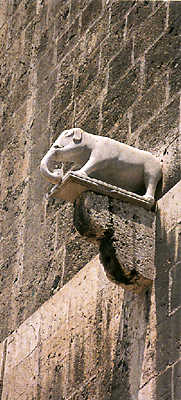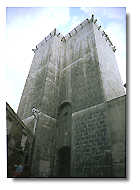
The strategic advantage of fortifying the Cagliari hills was first understood by Pisa,
which had won control of the city from Genoa in 1258.
The Pisan victors radically
transformed Cagliari, modeling the administrative and judicial systems after their
own. The greatest change was the construction of a wall around the hill, isolating the
Castello district from the rest of the city. Castello became the center of public
offices and the dwelling place of Pisan citizens.
The wall was the main defense for
the bustling Pisan trade activity. The districts of Marina, Stampace, and Villanova were
later surrounded by walls to better defend the port.
Pisan dominance was soon threatened by the temporal politics of Pope Boniface VIII, who granted
Sardinia and Corsica to Giacomo II of Aragon in 1297.
In response, Pisa reinforced Castello's walls by constructing
two defensive towers: Torre di S. Pancrazio in 1305 and Torre dell'Elefante in 1307,
designed by the Sardinian architect Giovanni Capula.
Pisan concern was not unfounded. Aragon prepared to attack the city in 1323, positioning
a fleet in the Gulf of Palmas as a starting point for their siege.
In 1324, the treaty stipulated between Pisa and Aragon put an end to Pisan rule in Sardinia and
marked the beginning of Iberian domination. Three years later, approval of the Coeterum
sanctioned the suspension of Pisan law.
|







